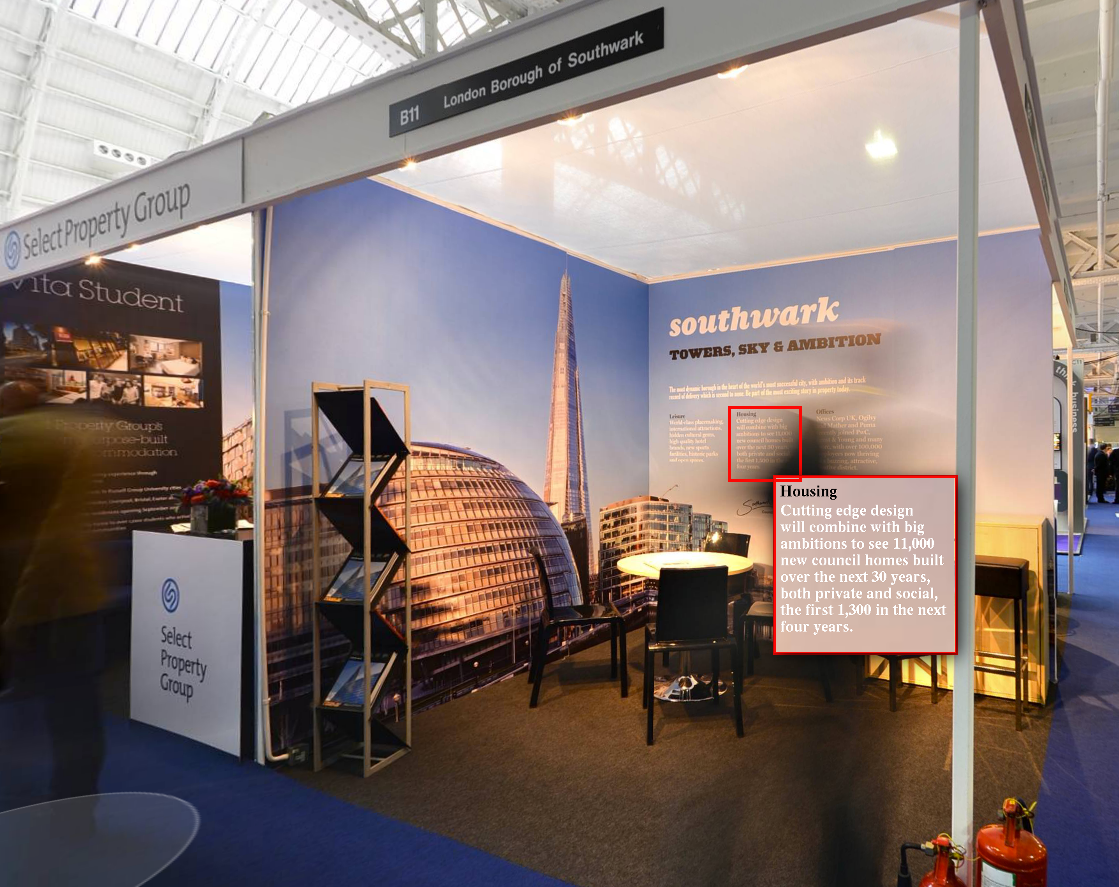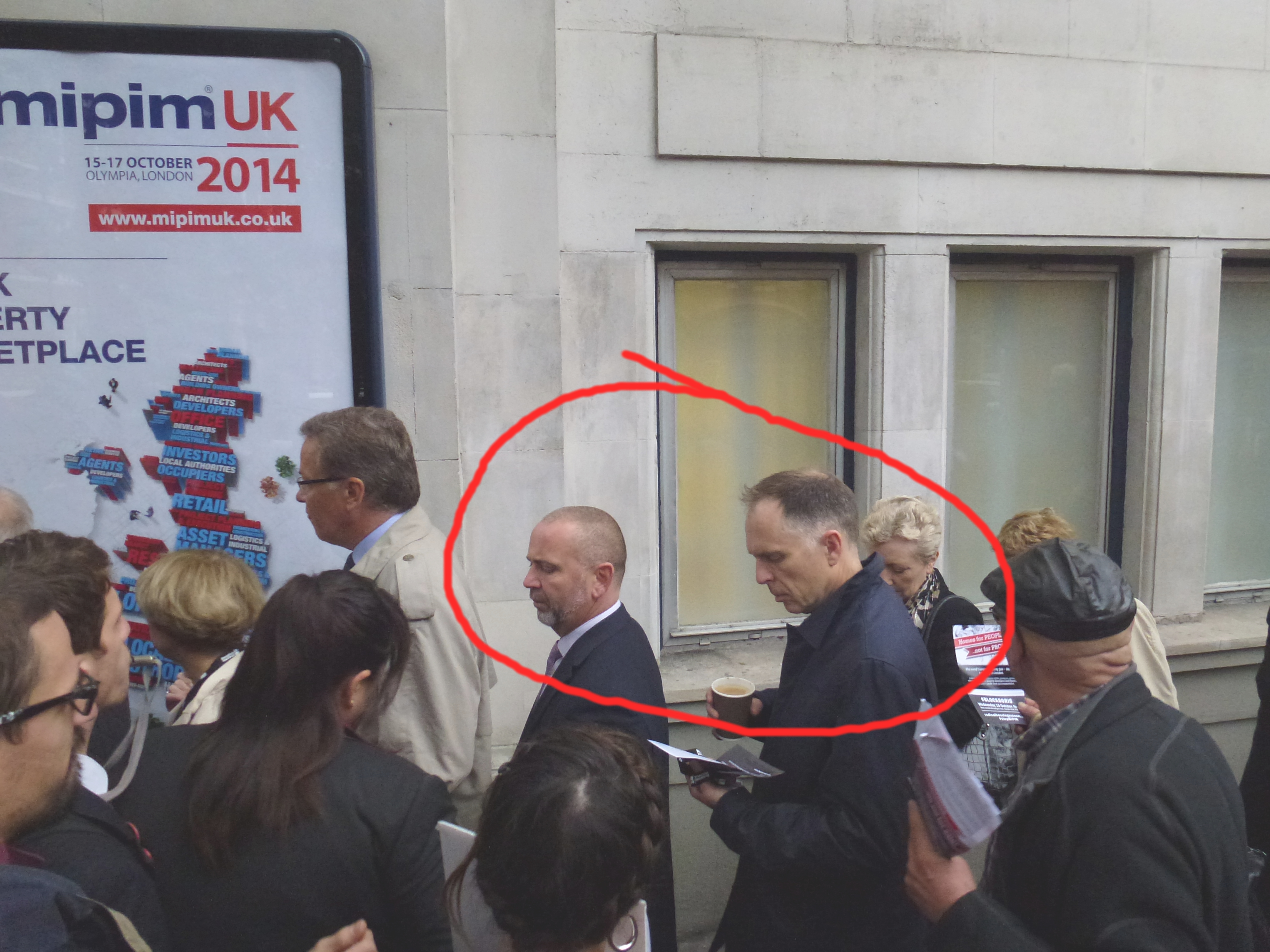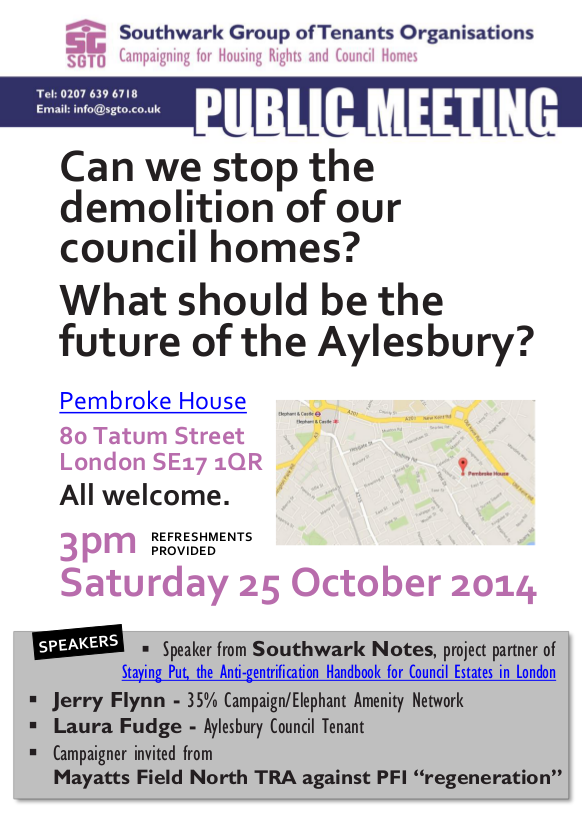 The MIPIM Jamboree last week attracted much protest and media comment, including articles in the Guardian and on the Left Foot Forward blog, which noted that “the Heygate Estate has become the paradigmatic example of the MIPIM-model of property development”.
The MIPIM Jamboree last week attracted much protest and media comment, including articles in the Guardian and on the Left Foot Forward blog, which noted that “the Heygate Estate has become the paradigmatic example of the MIPIM-model of property development”.
 MIPIM itself revealed the contrasting attitudes of 3 London Labour boroughs towards developers:
Hammersmith & Fulham used their stand to make a strong case for development that provides “Homes for residents, not overseas investors”. It highlighted developers using “ridiculous viability assessments that offer piffling amounts of affordable homes”.
MIPIM itself revealed the contrasting attitudes of 3 London Labour boroughs towards developers:
Hammersmith & Fulham used their stand to make a strong case for development that provides “Homes for residents, not overseas investors”. It highlighted developers using “ridiculous viability assessments that offer piffling amounts of affordable homes”.
Islington council leader Richard Watts said in his response to Unite’s call for a boycott: “neither I nor anyone else from Islington council will be attending the event”. He explained that he was “deeply concerned at the lack of genuinely affordable housing in London .. and the increase in foreign investors who are pushing up housing prices to the detriment of our residents.”
Southwark council leader Peter John’s response took a different view. He said he would be unable to attend himself, but “does not agree with the request and the reasoning behind it” because the council needs to “continue working with the private sector to ensure that we can deliver as many homes as we can”. He concludes by reiterating his “commitment to build 11,000 new council homes at social rents.”
This commitment to build 11,000 new council homes has come under increasing scrutiny. Our previous blog post and this recent Guardian article show how questions are being asked about whether they will be council homes and whether existing council homes will have to be lost for there to be any gains. So it’s not reassuring that Southwark’s MIPIM stand display describes the 11,000 new council homes as comprising “both private and social” housing as this image below shows:


If you would like to enjoy the full MIPIM experience without the canapés and champagne, click on this interactive floorplan of the property fair.
Developers ride the bus
 We hope if you live in Southwark, you didn’t see this bus driving down your street last week. It was full of MIPIM property developers making a quick trip from Earls Court, no doubt scoping out sites in the developer-friendly ‘can do’ borough of Southwark.
We hope if you live in Southwark, you didn’t see this bus driving down your street last week. It was full of MIPIM property developers making a quick trip from Earls Court, no doubt scoping out sites in the developer-friendly ‘can do’ borough of Southwark.
Evicting Aylesbury
 A High Court ruling condemning Southwark officers for having conspired to evict a tenant from an estate in its North Peckham regeneration, is followed by news of a temporary tenant on the Aylesbury estate evicted and left entirely homeless. HASL staged a protest in the Council’s HQ on Thursday accompanied by the Focus E15 mums and the evictee; and refused to leave the lobby until the poor disabled woman was given a roof over her head. Southwark acquiesced to the request and she was offered temporary accommodation (albeit with stairs..)
A High Court ruling condemning Southwark officers for having conspired to evict a tenant from an estate in its North Peckham regeneration, is followed by news of a temporary tenant on the Aylesbury estate evicted and left entirely homeless. HASL staged a protest in the Council’s HQ on Thursday accompanied by the Focus E15 mums and the evictee; and refused to leave the lobby until the poor disabled woman was given a roof over her head. Southwark acquiesced to the request and she was offered temporary accommodation (albeit with stairs..)
Aylesbury estate SGTO meeting
 The disruptive impact of regenerations like the Heygate and the Aylesbury on people throughout Southwark has become more apparent day by day. It is not just that council tenants lose their homes, but that leaseholders get displaced and that housing and rehousing opportunities are lost for anyone on the council waiting list. The Southwark Group of Tenants Association has called a public meeting about the future of the Aylesbury estate and the demolition of council homes. Threatened Aylesbury leaseholders will also be taking part in the meeting. In the meantime - 3 weeks since their submission - the Aylesbury planning applications have appeared on Southwark Council’s planning portal (ref. numbers 14/AP/3843 and 14/AP/3844) but we can’t tell whether the applications meet with affordable housing requirements because there are still no planning documents online. Last week we emailed the council’s planning dept to ask about the delay and we have still had no reply.
The disruptive impact of regenerations like the Heygate and the Aylesbury on people throughout Southwark has become more apparent day by day. It is not just that council tenants lose their homes, but that leaseholders get displaced and that housing and rehousing opportunities are lost for anyone on the council waiting list. The Southwark Group of Tenants Association has called a public meeting about the future of the Aylesbury estate and the demolition of council homes. Threatened Aylesbury leaseholders will also be taking part in the meeting. In the meantime - 3 weeks since their submission - the Aylesbury planning applications have appeared on Southwark Council’s planning portal (ref. numbers 14/AP/3843 and 14/AP/3844) but we can’t tell whether the applications meet with affordable housing requirements because there are still no planning documents online. Last week we emailed the council’s planning dept to ask about the delay and we have still had no reply.
Heygate FOI/EIR Tribunal Case
Parties to the Heygate FOI/EIR Tribunal case reconvened at a ‘Case Management Hearing’ last week. The hearing was called by respondent to the case Adrian Glasspool, who had complained that disclosure of the viability assessment had still not taken place following the Tribunal’s decison at the beginning of May. After hearing an account of progress so far, Southwark, Lend Lease and the Information Commissioner were directed to meet on 29th October to try to resolve any outstanding issues concerning the final disclosure. The judge also asked for parties’ availability for a further hearing - should it be needed - in December.
Another challenge against a developer’s use of viability assessments in Stoke Newington can be added to the list of challenges in our previous blog post. Again the developer is arguing that local people simply would not understand what it is all about, just as was the argument in the Heygate FOI/EIR Tribunal case. After 3 days of argument in the High Court, the judge has retired to consider his verdict.
Lyons Review reviews viability
 Viability assessments are also rapidly rising up the political agenda: the Lyons Housing Review commissioned by the Labour Party and published last week, has identified “substantial concerns about the way in which the viability of local plans, CIL charging schedules and sites are tested. Evidence to the review suggested that this is compounded by the fact that there is no agreed methodology for viability assessment, which allows different parties to pick the methodology most to their advantage .. evidence to the review suggested that the current arrangements create a great deal of uncertainty and complexity, which works in favour of the partner with the most skilled consultants acting for it.”
Viability assessments are also rapidly rising up the political agenda: the Lyons Housing Review commissioned by the Labour Party and published last week, has identified “substantial concerns about the way in which the viability of local plans, CIL charging schedules and sites are tested. Evidence to the review suggested that this is compounded by the fact that there is no agreed methodology for viability assessment, which allows different parties to pick the methodology most to their advantage .. evidence to the review suggested that the current arrangements create a great deal of uncertainty and complexity, which works in favour of the partner with the most skilled consultants acting for it.”
The report then makes some suggestions for how the viability testing process can be improved:
“Definitive guidance should be produced to ensure a single and robust methodology for viability assessments to reduce the scope for different interpretations of viability and reduce uncertainty.” It argues that an “‘open-book’ approach to negotiating site specific viability is required, to increase transparency and speed of negotiations.” It also proposes “an arbitration service for S106 on large scale developments to be funded by the parties involved in the negotiation”.
